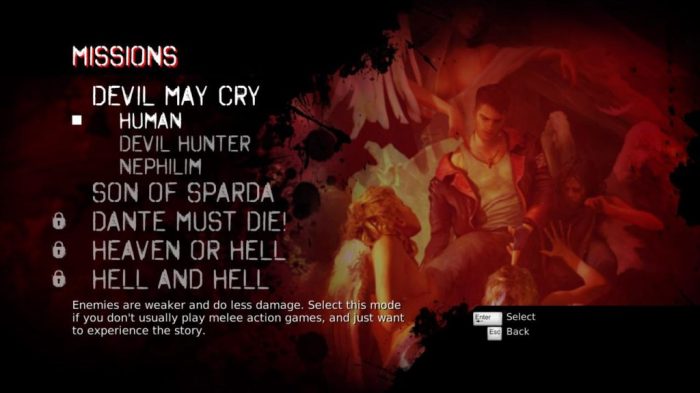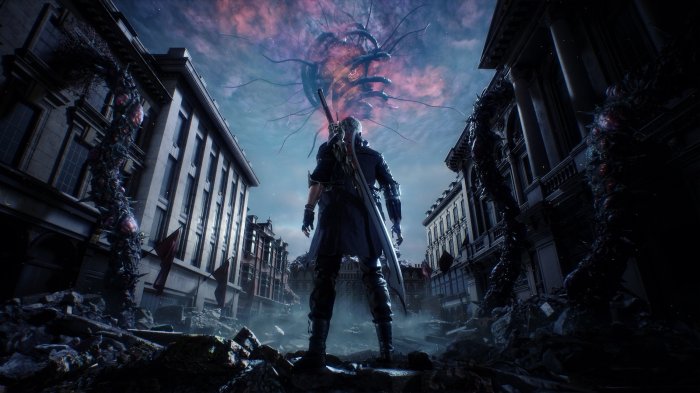Devil May Cry difficulty is a defining characteristic of the series, offering a challenging yet rewarding gameplay experience. This article delves into the intricacies of the game’s difficulty, examining its impact on gameplay, community perception, and evolution throughout the series.
The unique blend of enemy design, level layout, and combat mechanics creates a difficulty curve that tests players’ skills and encourages strategic thinking.
Devil May Cry Difficulty
The Devil May Cry series is renowned for its stylish action gameplay, where players are tasked with defeating hordes of demonic enemies in a flashy and over-the-top manner. Difficulty plays a pivotal role in the series, adding depth and replayability to the core gameplay experience.
Difficulty in video games refers to the level of challenge players face while progressing through the game. It encompasses various aspects, such as enemy strength, level design, and combat mechanics. In Devil May Cry, difficulty is finely tuned to provide a rewarding experience for players of all skill levels.
Factors Contributing to Difficulty
- Enemy Design:Devil May Cry features a diverse array of enemies, each with unique abilities and attack patterns. Some enemies are more formidable than others, requiring players to adapt their strategies and master the game’s combat system.
- Level Design:The levels in Devil May Cry are meticulously crafted to present challenges and encourage exploration. Complex level layouts, hidden areas, and environmental hazards add depth to the gameplay and test players’ adaptability.
- Combat Mechanics:The core combat mechanics in Devil May Cry are complex and require precision and timing. Players must master the various weapons, abilities, and combos to effectively dispatch enemies and achieve high scores.
Difficulty Settings
Devil May Cry games offer a range of difficulty settings to cater to players of varying skill levels.
- Easy:Designed for beginners, Easy mode reduces enemy damage and increases item availability, making the game more accessible.
- Normal:The standard difficulty setting, Normal mode provides a balanced challenge that tests players’ skills without being overwhelming.
- Hard:A significant step up in difficulty, Hard mode increases enemy strength, reduces item availability, and introduces more challenging enemy encounters.
- Dante Must Die:The ultimate test of skill, Dante Must Die mode presents a brutal challenge with significantly stronger enemies and limited resources.
- Hell and Hell:Available in some games, Hell and Hell mode is the most difficult setting, pushing players to their limits with overwhelming enemy hordes and relentless bosses.
Impact on Gameplay

The difficulty of Devil May Cry games significantly influences the gameplay experience.
- Player Progression:Higher difficulty settings require players to grind more, master combat mechanics, and explore levels thoroughly to acquire upgrades and items.
- Strategy:Players must adapt their strategies to overcome increasingly challenging enemies. Each encounter requires careful planning and execution to achieve high scores.
- Enjoyment:For some players, overcoming the challenges of higher difficulty settings provides a sense of accomplishment and satisfaction.
Community Perception
The Devil May Cry community is passionate about the game’s difficulty. Players engage in discussions, share strategies, and compete for high scores on online leaderboards.
Some players appreciate the high difficulty, as it encourages mastery and replayability. Others prefer lower difficulty settings, allowing them to focus on the game’s story and action without the added challenge.
Evolution of Difficulty

The difficulty of Devil May Cry games has evolved over the series.
- Early Games:The original Devil May Cry games featured a relatively high level of difficulty, with limited checkpoints and unforgiving enemy encounters.
- Modern Games:While still challenging, modern Devil May Cry games offer more accessibility options and difficulty settings, catering to a wider range of players.
Comparison to Other Games, Devil may cry difficulty

Compared to other action games in the genre, Devil May Cry is generally considered to have a higher level of difficulty.
- Bayonetta:Similar to Devil May Cry, Bayonetta features stylish action gameplay but has a slightly lower difficulty curve, with more generous checkpoints and forgiving enemy encounters.
- God of War:While still challenging, God of War games offer a more balanced difficulty experience, with a greater emphasis on narrative and exploration.
Essential FAQs
What factors contribute to the difficulty of Devil May Cry games?
Enemy design, level design, combat mechanics, and AI behavior all play a significant role in determining the difficulty of Devil May Cry games.
How does difficulty affect gameplay in Devil May Cry?
Difficulty influences enemy strength, AI behavior, resource availability, and overall gameplay strategy.
How has the difficulty of Devil May Cry games evolved over time?
The difficulty levels have been refined and adjusted throughout the series, with newer installments offering a wider range of options to accommodate different player preferences.
